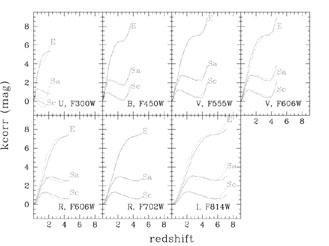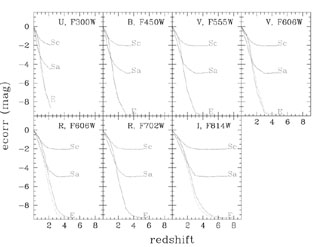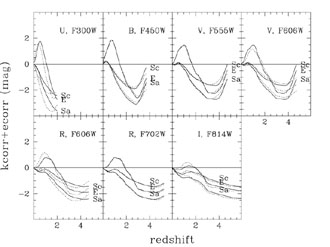


The fractional EBL23 flux which comes from detected sources is
simply the ratio of the flux in detected sources (measured by
"ensemble photometry") to the detected EBL23 (±
2 limits).
The maximum fractional EBL23 flux coming from undetected sources
is what remains: 0-65% at U300, 0-80% at
V555, and 0-80%
at I814. Although these limits include the possibility
of no additional contribution from undetected sources, it is worthwhile to
note that if the progenitor of a normal disk galaxy at z = 0.1
(central surface brightness
µ0(V) ~ 21.3 mag arcsec-2 and
V ~ 22 mag) existed at z ~ 2, then the z ~ 2 progenitor
would have a core surface brightness (within 0.2 × 0.2
arcsec2)
of ~ 26 mag arcsec-2 for standard K-corrections
and passively evolving stellar populations (e.g.
Poggianti 1997),
which is roughly the detection limit for the HDF. In particular,
regardless of the exact evolutionary or k-corrections, dimming due to
cosmological effects alone (redshift and angular resolution) produce
~ 5 mag of surface brightness dimming. This effect is independent
of wavelength, so that dimming at other bandpasses is similar, modulo
differences in the evolutionary and K-corrections (shown in
Figures 12, 13 and
14). At I, for example,
the drop in surface brightness for a disk galaxy at z ~ 2 relative
to z ~ 0 is ~ 0.5 mag greater than for V. The progenitor of
a typical disk galaxy at z = 0.1, which has V - I ~
0.9 and
µ0(I) ~ 20.3 mag arcsec-2
(de Jong & Lacey 2000),
will have V - I ~ 0.5 at z ~ 2 and
µ0(I) ~ 25.5. Thus the typical
disk galaxy at z ~ 2 is close to the HDF detection limit in
I as
well as V. Irrespective of the color evolution with redshift, the
point is that cosmological surface brightness dimming alone suggests
that a significant fraction of the EBL23 may come from normal galaxies
at redshifts z < 4 which are undetectable in the HDF.
Furthermore, recent redshift surveys for low surface brightness (LSB)
galaxies now suggest that the distribution of galaxies in
µ0 is nearly flat for
µ0 > 22.0B mag arcsec-2 at
some luminosities
(Sprayberry et al.
1997,
Dalcanton et al.
1997,
O'Neil & Bothun 2000,
Blanton et al. 2001,
Cross et al. 2001).
If such populations exist at high redshift, they may contribute significant
flux to the EBL as presently undetectable sources.
limits).
The maximum fractional EBL23 flux coming from undetected sources
is what remains: 0-65% at U300, 0-80% at
V555, and 0-80%
at I814. Although these limits include the possibility
of no additional contribution from undetected sources, it is worthwhile to
note that if the progenitor of a normal disk galaxy at z = 0.1
(central surface brightness
µ0(V) ~ 21.3 mag arcsec-2 and
V ~ 22 mag) existed at z ~ 2, then the z ~ 2 progenitor
would have a core surface brightness (within 0.2 × 0.2
arcsec2)
of ~ 26 mag arcsec-2 for standard K-corrections
and passively evolving stellar populations (e.g.
Poggianti 1997),
which is roughly the detection limit for the HDF. In particular,
regardless of the exact evolutionary or k-corrections, dimming due to
cosmological effects alone (redshift and angular resolution) produce
~ 5 mag of surface brightness dimming. This effect is independent
of wavelength, so that dimming at other bandpasses is similar, modulo
differences in the evolutionary and K-corrections (shown in
Figures 12, 13 and
14). At I, for example,
the drop in surface brightness for a disk galaxy at z ~ 2 relative
to z ~ 0 is ~ 0.5 mag greater than for V. The progenitor of
a typical disk galaxy at z = 0.1, which has V - I ~
0.9 and
µ0(I) ~ 20.3 mag arcsec-2
(de Jong & Lacey 2000),
will have V - I ~ 0.5 at z ~ 2 and
µ0(I) ~ 25.5. Thus the typical
disk galaxy at z ~ 2 is close to the HDF detection limit in
I as
well as V. Irrespective of the color evolution with redshift, the
point is that cosmological surface brightness dimming alone suggests
that a significant fraction of the EBL23 may come from normal galaxies
at redshifts z < 4 which are undetectable in the HDF.
Furthermore, recent redshift surveys for low surface brightness (LSB)
galaxies now suggest that the distribution of galaxies in
µ0 is nearly flat for
µ0 > 22.0B mag arcsec-2 at
some luminosities
(Sprayberry et al.
1997,
Dalcanton et al.
1997,
O'Neil & Bothun 2000,
Blanton et al. 2001,
Cross et al. 2001).
If such populations exist at high redshift, they may contribute significant
flux to the EBL as presently undetectable sources.

|
Figure 12. K-corrections for various filters as a function of redshift calculated using Poggianti (1997) SEDs for present day E, Sa, and Sc galaxies. Bandpasses are standard Johnson/Cousins filters and the corresponding WFPC2 filters, shown with solid and dotted lines, respectively. |

|
Figure 13. Evolutionary corrections for various filters as a function of redshift calculated using Poggianti (1997) SEDs for E, Sa, and Sc galaxies evolving passively with redshift. Bandpasses are standard Johnson/Cousins filters and the corresponding WFPC2 filters, shown with solid and dotted lines, respectively. |

|
Figure 14. The sum of the evolutionary and K-corrections for Johnson/Cousins (solid lines) and WFPC2 filters (dotted lines) shown in Figures 12 and 13. |
In this section, we explore the possible contributions to the EBL23
from galaxies at all redshifts which escape detection in the HDF
because of low apparent surface brightness. To do so, we have
simulated galaxy populations at redshifts 0 < z < 10 as the
passively evolving counterparts of local galaxy populations and then
"observed" the simulated galaxies through the Gaussian 0.1" FWHM
point spread function of WFPC2. We define the surface brightness
detection threshold to be consistent with the
5 detection
limits of the HDF images (see
Table 3), which
correspond to roughly the turn-over magnitude in the number counts.
This exercise is not meant to approximate realistic galaxy populations
at high redshift; the evolution of galaxy populations in surface
brightness, luminosity, and number density is so poorly constrained at
present that more specific modeling is unwarranted. The models
discussed here simply address the question: how much of the total flux
from a local-type galaxy population at a redshift z can be resolved
into individual sources?
detection
limits of the HDF images (see
Table 3), which
correspond to roughly the turn-over magnitude in the number counts.
This exercise is not meant to approximate realistic galaxy populations
at high redshift; the evolution of galaxy populations in surface
brightness, luminosity, and number density is so poorly constrained at
present that more specific modeling is unwarranted. The models
discussed here simply address the question: how much of the total flux
from a local-type galaxy population at a redshift z can be resolved
into individual sources?
